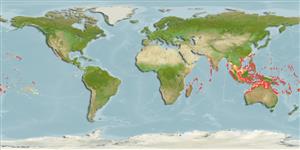Common names from other countries
>
Aulopiformes (Grinners) >
Synodontidae (Lizardfishes) > Synodontinae
Etymology: Synodus: Greek, syn, symphysis = grown together + Greek, odous = teeth (Ref. 45335).
More on author: Schultz.
Environment: milieu / climate zone / depth range / distribution range
Ökologie
seewasser riff-verbunden; tiefenbereich 1 - 88 m (Ref. 86942), usually 1 - 10 m (Ref. 11228). Tropical; 26°N - 24°S
Indo-Pacific: Gulf of Aden and East Africa to the Hawaiian and Gambier islands, north to the Ogasawara Islands, south to the Great Barrier Reef.
Size / Gewicht / Alter
Maturity: Lm ? range ? - ? cm
Max length : 18.0 cm TL Männchen/unbestimmt; (Ref. 11228); common length : 10.0 cm TL Männchen/unbestimmt; (Ref. 3520)
Rückenflossenstacheln (insgesamt) : 0; Rückenflossenweichstrahlen (insgesamt) : 12 - 14; Afterflossenstacheln: 0; Afterflossenweichstrahlen: 8 - 10. Cheek behind mouth scaled; palatine teeth in a single band on each side (characteristic of the genus); membranous flap on anterior nostrils long and broad; dorsal tip of snout with a pair of small but prominent black spots (Ref. 2334).
Occurs in coral reefs (Ref. 11228). Benthic (Ref. 58302). Generally solitary and typically rests on hard surfaces, occasionally with a head down position on a steep slope (Ref. 1602). Feeds on small fishes and shrimps (Ref. 89972). Sold fresh in markets.
Life cycle and mating behavior
Maturities | Fortpflanzung | Spawnings | Egg(s) | Fecundities | Larven
Cressey, R.F. and R.S. Waples, 1984. Synodontidae. In W. Fischer and G. Bianchi (eds.) FAO species identification sheets for fishery purposes. Western Indian Ocean (Fishing Area 51). Volume 4. FAO, Rome. (Ref. 3520)
IUCN Rote Liste Status (Ref. 130435)
CITES (Ref. 128078)
Not Evaluated
Bedrohung für Menschen
Harmless
Nutzung durch Menschen
Fischereien: weniger kommerziell
Tools
Zusatzinformationen
Download XML
Internet Quellen
Estimates based on models
Preferred temperature (Ref.
115969): 25.3 - 29.3, mean 28.4 (based on 3181 cells).
Phylogenetic diversity index (Ref.
82804): PD
50 = 0.5000 [Uniqueness, from 0.5 = low to 2.0 = high].
Bayesian length-weight: a=0.00447 (0.00211 - 0.00945), b=3.16 (2.99 - 3.33), in cm Total Length, based on LWR estimates for this Genus-body shape (Ref.
93245).
Trophic level (Ref.
69278): 4.0 ±0.7 se; based on size and trophs of closest relatives
Widerstandsfähigkeit (Ref.
120179): hoch, Verdopplung der Population dauert weniger als 15 Monate. (Preliminary K or Fecundity.).
Fishing Vulnerability (Ref.
59153): Low vulnerability (10 of 100).
